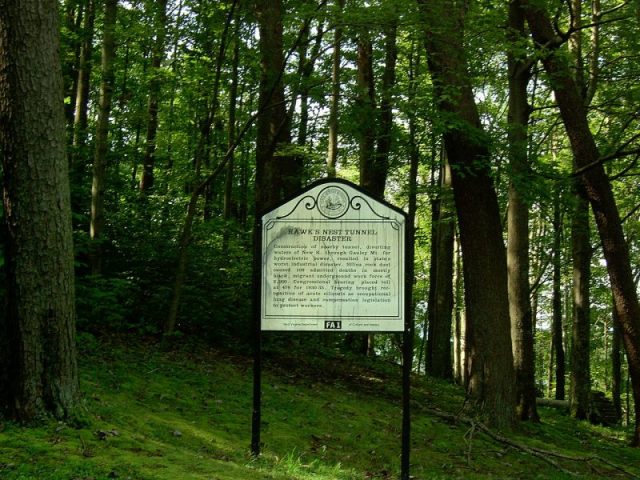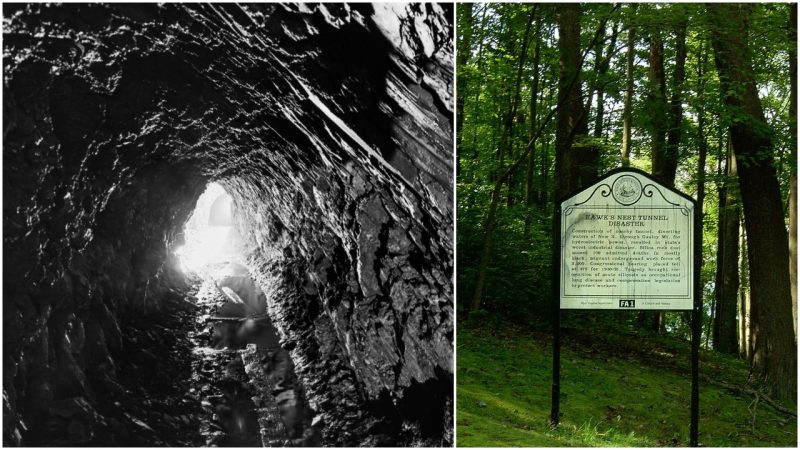It was called “the town of the living dead.”
For a time, the community of Gauley Bridge in West Virginia was unfairly saddled with that dark label because of work nearby–work with good pay during the Great Depression when any jobs were scarce. Those paychecks were from nearby Hawk’s Nest Tunnel blasted out between 1930 and 1932.
The jobs were a breath of fresh air for both the locals who landed them and the migrant workforce recruited. Most of the latter were black men from the South.
Fresh air, however, was the very problem. What the men who signed on didn’t know was that tiny particles in tunnel’s dusty air were killing them. In some cases, workers died so quickly that their bodies were dumped in fields and covered in rubble.
Highly concentrated silica dust clogged and quicky scarred their lungs, choking off their ability to absorb oxygen. Company doctors labeled it “tunnelitis,” but it was actually silicosis, a known mining hazard. And while silicosis is typically slow to kill, these men were exposed to a kind that was highly concentrated and freshly fractured – in other words, extremely hazardous.
What happened at Hawk’s Nest is now considered one of the worst industrial disasters in American history, killing, by modern estimates, up to 2,000 people.
The three-mile-tunnel system through Gauley Mountain was built by Union Carbide to divert the New River–now a popular whitewater rafting destination–to generate hydropower for its metals plant at Alloy, West Virginia. Union Carbide contracted with Rinehart & Dennis of Charlottesville, Virginia, to oversee the work.

That silica found in the diversion tunnel was considered a bonanza and was mined for use in metal-making by Union Carbide. Protections were required for miners working in silica dust, although they would have been primitive by today’s standards. Masks were generally required, and dust control measures like wetting down surfaces helped. Upper-echelon visitors to the Hawk’s Nest project were issued protective masks, but laborers who often put in 60 hours a week in the tunnel were not. Water was not used to keep the dust down.
The project had been licensed under civil engineering, not mining, so the measures were not required. A third of the tunnel was enlarged strictly for mining the silica.
Laborers’ stints on the job typically didn’t last long, despite their hunger for work. Helen Lang, a geology professor at West Virginia University, has some staggering statistics: 60 percent worked less than two months, 80 percent less than six months, and 90 percent less than a year.
“Why did so many work less than the total duration of the project when jobs were very scarce and pay was relatively good?” asked Lang in EHS Today, an occupational health and safety magazine.
The answer was silicosis. Men quickly got sick, with out-of-towners sent home if possible. The condition snuffed out some so fast that they were buried locally. In an era of Jim Crow, black workers had it the worst. Local white cemeteries wouldn’t accept black burials, hence the unmarked makeshift graves.
In an effort to keep the problem quiet, sick men and their families were often told they had tuberculosis, pneumonia, or other respiratory ailments. But with so many sick and dying, word leaked out. Two major lawsuits were filed against the contractor and against New Kanawha Power Co., a corporate entity created by Union Carbide. Only modest individual out-of-court settlements were paid: from $30 to $1,600. Whites workers or their survivors were given substantially more than the blacks who worked beside them.
The largest of the trials ended with a hung jury with accusations and evidence of jury tampering.
The death toll, once pegged at 476, surely was much higher, according to environmental experts who have studied the incident–closer to from 1,500 to 2,000. They said many deaths went unreported because the men who were sent away died quietly or were misdiagnosed. Silicosis also sets the lungs up for other fatal illnesses.
Organized efforts to suppress news of the disaster were made in West Virginia. In the late 1930s, Gov. Homer Holt refused to sanction a Federal Writer’s Guide on the history of West Virginia until the writers toned down the section on Hawk’s Nest. Then, after leaving office, Holt served as general counsel of Union Carbide.
Many writers and poets refused to be silenced. Among the best known of their work is the late Muriel Rukeyser’s poetry sequence, The Book of the Dead. In the poem about Hawk’s Nest she asks (and answers): “What three things can never be done? Forget. Keep silent. Stand-alone.”
Terri Likens‘ byline has appeared in newspapers around the world through The Associated Press. She has also done work for ABCNews, the BBC, and magazines that include High Country News, American Profile, and Plateau Journal. She lives just east of Nashville, Tenn.
